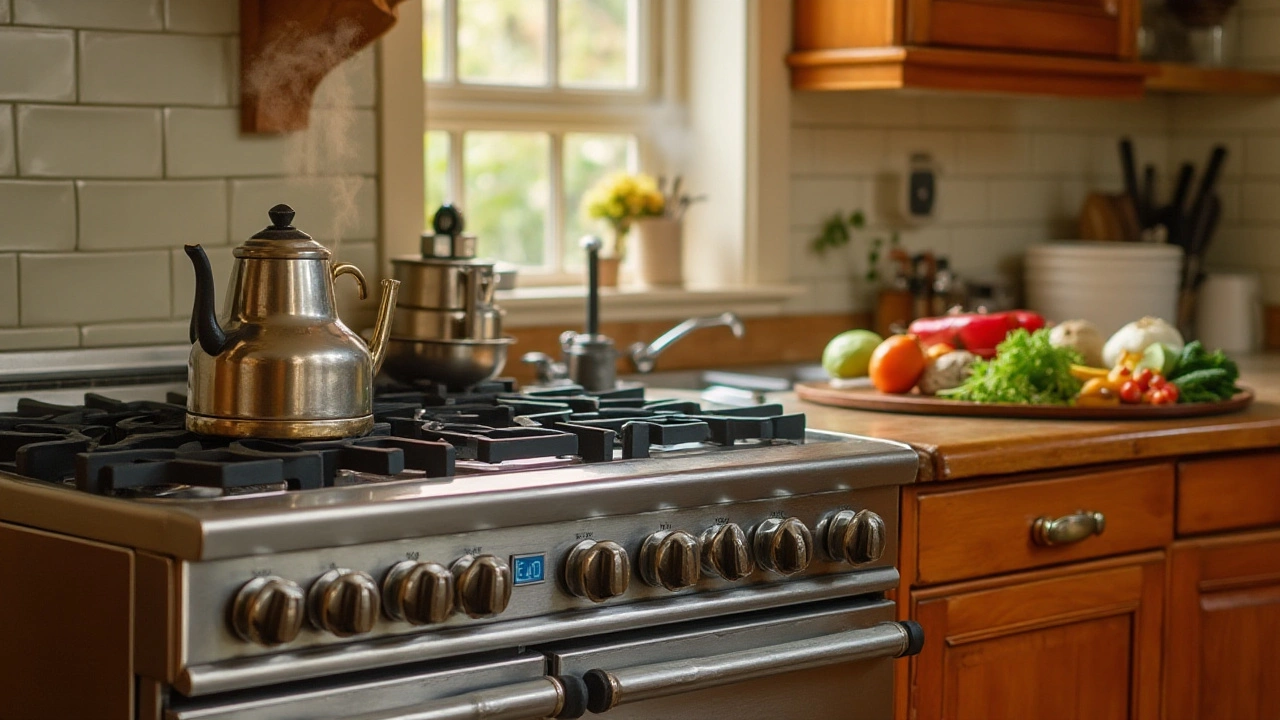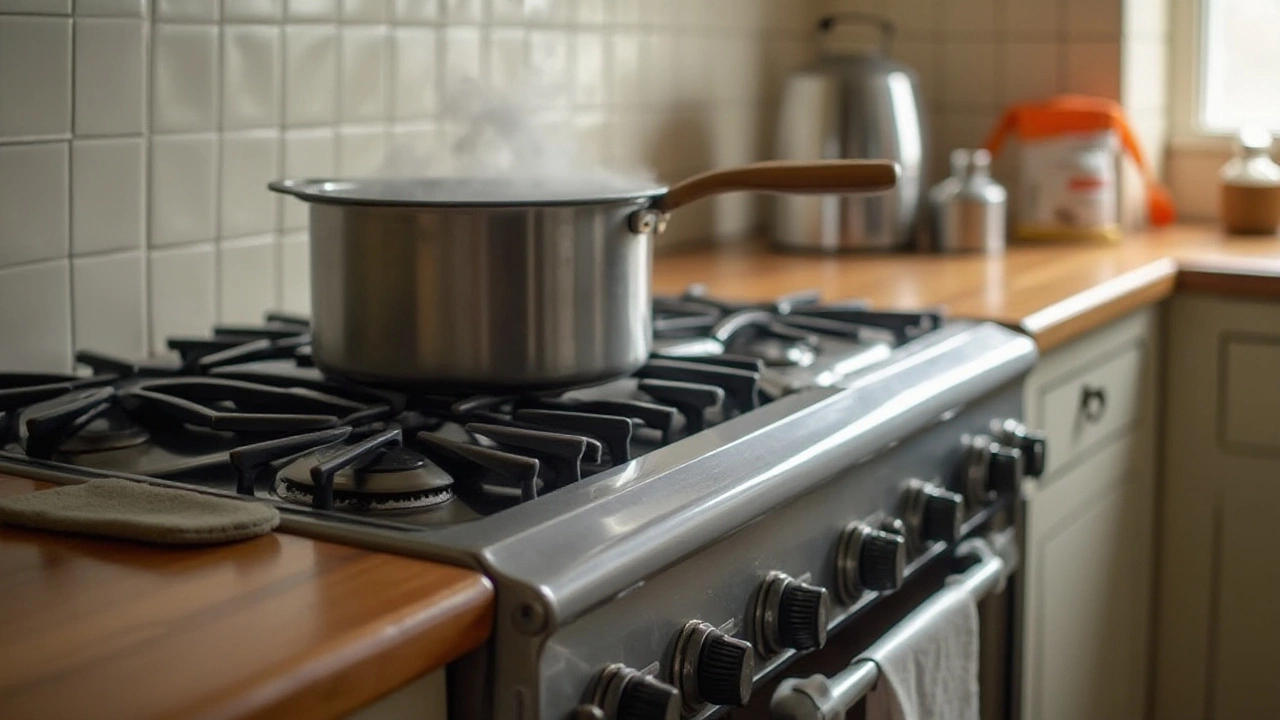
- 16 Oct 2024
- Gideon Thornton
- 0
For many of us, the kitchen is the heart of the home, and at its core stands the gas hob—a trusty companion for everything from gently simmered sauces to a quick pasta for tea. A well-maintained gas hob can reliably serve its culinary purpose for over a decade, surviving the stews, spills, and sizzles we throw at it.
But what really determines how long a gas hob will last? Several factors come into play. The brand and model can be the first significant indicators, though not alone. Usage pattern—how often and intensely it’s called into action—plays a massive part, as does the care you provide it. With a little knowledge and some practical care tips, you can not only prolong the life of your gas hob but also ensure every meal starts without a hitch.
- Introduction to Gas Hob Lifespan
- Factors Influencing Gas Hob Durability
- Maintenance Tips for Longevity
- Common Repairs and When to Call a Professional
- Signs It Might Be Time for a Replacement
- Practical Tips and Techniques
Introduction to Gas Hob Lifespan
When it comes to the kitchen, the gas hob stands as a steadfast icon of culinary importance. Their elegant, clean flame gives unparalleled control and has made them a preferred choice for both novice cooks and seasoned chefs alike. But, like any kitchen appliance, it's natural to wonder about its longevity. Generally, a gas hob has a lifespan of about 10 to 15 years, although this can vary depending on several influencing factors. The type of gas hob, frequency of use, maintenance techniques, and even the quality of installation can all contribute to its lifespan. It's a mix of these elements that dictates how long yours will stay operational.
Understanding these factors can make a significant impact on maximizing the lifespan of your gas hob. For instance, regular cleaning not only maintains its appearance but also ensures functionality by preventing blockages in the burners. The choice of materials can also play an instrumental role; stainless steel models are often preferred for their resilience and ease of cleaning. Another component of longevity is the degree to which the hob is used. Hobs that see minimal usage unsurprisingly outlast those subjected to daily use. Combine these insights with precautionary steps like checking for leaks, prompt repairs, and using the hob mindfully to avoid overheating specific parts, and you can comfortably extend its life beyond the expected years.
Expert cook and chef, Marco Pierre White, once said: "Cooking is about passion, so it may look slightly temperamental in a way; it's like the artists you know. Their canvas is their compositions, the stove their most important tool." By drawing parallels between the artist’s tools and our kitchen appliances, he underscores not only the importance but also the care they deserve.
Moreover, with kitchens evolving to meet contemporary needs, some are turning to hobs with additional features and technology—anything from digital controls to automatic shut-off capabilities. This addition not only enhances functionality but may also influence the longevity of a hob. However, always remember that even the most advanced models require prudent use and maintenance. A key takeaway here is that being proactive can significantly extend the functional life of your gas hob. Think of it as adopting a nurture approach—that is, treating your hob with attention, it deserves to reach those upper limits in years.
Let us not forget that environmental factors also play a part. Kitchens with good ventilation not only benefit the cook but also help keep the gas hob in good condition by preventing residue build-up around the burners. With a healthy blend of maintenance skills, the right usage habits, and a touch of culinary passion, your gas hob could not only meet but exceed its expected lifespan. So, equip yourself with these insights and ensure your hob remains a reliable kitchen companion for years to come.
Factors Influencing Gas Hob Durability
When it comes to the longevity of a gas hob, several aspects come into play that determine whether it will last for just a handful of years or become a longstanding fixture in your kitchen. Initially, the quality and brand of the hob can set the tone. High-end brands often invest in better materials and innovative design, making them a favored choice among savvy homeowners. Yet, it's not just about price tags and brand logos; regular care and attention significantly extend its operational life. Routine cleaning, proper cooking techniques, and avoiding unnecessary stress to the burners are some of the everyday decisions that can save you from premature replacements.
The frequency of use is another critical factor. A hob in a bustling family kitchen sees more action than one in a single-person household, affecting wear and efficiency. Those who love entertaining or cook many meals might find they need to pay extra attention to maintenance. Beyond that, environmental conditions play their part too. In coastal areas, for example, the salt air might contribute to faster corrosion rates. Mechanical stress from regular installation and removal for deep cleaning or repairs can also wear down components over time, so handling with care is quite essential.
Materials and Manufacturing Standards
Another critical component of your gas hob’s lifespan lies in its materials and the standards with which it's made. Manufacturers that adhere to stringent industry standards produce hobs that resist wear and tear more effectively. Metals like stainless steel and cast iron often make for more durable grates and burners. These metals are known for their enduring nature and can withstand higher heats and potential impact during cleaning sessions. The control knobs on a hob are another area where quality materials come into play. Knobs that break or become difficult to turn can be a source of daily frustration. High-quality knobs are generally built to last, holding up well against the repetitive turning and pushing they face daily.
Sometimes, it’s enlightening to heed the wisdom of industry experts. A study by the Home Appliance Manufacturers Association suggests, "Proper component materials, combined with conscientious user practices, play a pivotal role in extending appliance life." Such insights highlight the importance of not only the maker but also our everyday role in our hob’s longevity.

Maintenance Tips for Longevity
As with many home appliances, keeping your gas hob in tip-top shape requires a mixture of regular, tender care and a touch of know-how. The key to extending the life of your gas hob lies in consistent maintenance practices and understanding the small signs that might hint at an issue lurking below the surface. First and foremost, it's important to develop the habit of cleaning your hob after every cooking session. This ensures that food residues, which can easily turn into stubborn stains if left unchecked, are removed before they solidify. To do this effectively, use a mixture of warm water and mild dish soap. Steer clear of harsh chemicals that can scratch or discolor the hob surface. Don’t forget to dry it thoroughly, as lingering moisture can lead to rust on metal components over time.
Apart from cleaning, keeping an eye on the burners is crucial. The orifices in your gas hob burners are the heart of its operation, allowing the proper flow of gas for even cooking flames. If you notice uneven flame distribution or failed ignition, it's worthwhile to inspect for clogs. You can gently use a small brush or a pin to clear any debris. Regular checking ensures your burners perform optimally and reduces the risk of gas leaks. Also, inspect gas connections occasionally to ensure they're secure and free from damage. Replace corroded or frayed hoses promptly to prevent any mishaps. As part of your maintenance routine, remember to take a peek underneath the hob from time to time. Dust and debris can accumulate in the areas you overlook, potentially blocking vents and affecting performance.
Given that the hob is often an unsung hero of the kitchen, utilized almost daily, it's easy to overlook the need for professional check-ups. Yet, just like a car, an appliance like this benefits from regular professional servicing. An expert can spot finer issues that you might miss, lubricate moving parts, and ensure the appliance is working efficiently. Many experts suggest a check-up every two to three years for heavily-used hobs. As Mark Jones, an experienced technician with years of servicing kitchen appliances, states,
"A small touch of professional care once in a while can add years to your hob's life, saving you from unexpected repairs or replacements."This advice, although simple, underscores the value of professional insight. The expert touch can catch what might slip through the cracks in everyday care.
Common Repairs and When to Call a Professional
A **gas hob** is a trusty tool in our kitchen arsenal, but like all appliances, it can face a few common hiccups along the way. One of the most frequent issues is the pesky problem of the burner not lighting properly. Often, this happens when the igniter is clogged or gets damp. In some cases, a simple cleaning can do wonders. Turning off the gas, lifting the burner top, and gently cleaning around the igniter with a toothbrush can sometimes solve the problem. However, if you detect any unusual spark, or the issue persists, it might be time to have a professional take a look, as they can ensure there are no underlying concerns like faulty wiring or a gas leak—serious business that requires expert attention.
Another common concern is erratic flames or those that burn an odd color. Ideally, your burners should emit a steady blue flame. If they’re yellow or orange, that’s a red flag for potential combustion problems. Often, this could mean the burner is dirty, or there might be gas flow issues. After trying safe cleaning tactics, if the problem still stands, it could be prudent to consult a professional. They have the tools and knowledge to assess gas pressure and flow, which is vital for safe operation. Ignoring these signs could result in reduced cooking performance or, worse, safety risks in your home.
A rarer but possible issue is finding that the dial won’t turn easily. Grease build-up over time can cause knobs to stick. To address this, try removing the knob (some pull off easily) and cleaning carefully around the spindle. Cleaning can often resolve the problem, but these mechanisms can wear out with age. If the hob is relatively aged and there's no improvement, replacing the parts might be necessary. At this point, a professional’s expertise in identifying the exact replacement could be your best bet.
"Understanding when to repair or replace your essential kitchen appliances could save you unnecessary costs and keep your kitchen running smoothly. Gas appliances, in particular, should be regularly maintained for safe operation," says Alan Watkins, a respected figure in home appliance services.
Let’s not forget the vital aspect of safety around gas hobs. Anything that involves gas should be approached with caution. While minor cleaning can often sort out problems, when any gas aspect seems out of place, such as a smell of gas or persistent burner faults, calling in a Gas Safe registered engineer is non-negotiable. Regularly having your gas hob serviced can also ensure any potential issues are nipped in the bud before they grow into a more serious concern. Proper maintenance and timely repairs can dramatically enhance your **gas hob's** lifespan and efficiency.
For those who enjoy a bit more technical feedback, here’s a simple table to guide when a professional might be necessary:
| Issue | DIY Solution | When to Call a Pro |
|---|---|---|
| Burner not igniting | Clean around igniter | Sparks or persistent issue |
| Flame incorrect color | Clean burner | Gas pressure assessment |
| Stiff knobs | Clean spindle area | No improvement after cleaning |

Signs It Might Be Time for a Replacement
The question when to replace a gas hob can often linger in the back of your mind, especially when you're noticing those subtle signs that things aren't as they used to be. One of the initial indicators can be inconsistent heating. Have you noticed your pasta boiling on one side but barely bubbling on the other? This is not a trick of imagination, but a sign that the burners, the heart of your cooking area, are beginning to wear out. As they age, they can lose efficiency, leading to uneven cooking that can be quite a headache during meal preparation. This could mean that internal components are failing, not distributing the gas properly to provide that consistent, perfect flame.
Another prominent sign is the persistent clicking sound. While a click or two at ignition is normal, a constant ticking could mean that the ignition switch is crying out for help—or replacement. If the gas hob continues to click even when turned off, this is a sign you shouldn’t ignore. It can be due to moisture, a problem with the ignition switch or the burner cap being out of alignment. Moreover, you could notice the satiating smell of gas more frequently or smell it faintly during operations. This, needless to say, should be cause for immediate concern as it points to potential leaks, which can be hazardous. You might want to bring in an expert to assess the safety and functionality of your gas hob.
"Safety should always be the primary concern; if you feel unsure about your gas hob's condition, consult a professional," says Mary Carter, a home appliance specialist from the Energy and Utilities Alliance.
Physical wear and tear shouldn't be overlooked either. If you're seeing a consistent build-up of spills and stains that just won't shift, no matter how thorough the cleaning, deterioration may be on the cards. Over time, the surface and knobs become less responsive, making it difficult to control heat. You might also encounter issues with the ignition becoming temperamental. Add wear and tear to ignition trouble, and you might find yourself best friends with the matches, not ideal nor safe.
So, how do you pinpoint the threshold between repair and replacement? Begin by evaluating repair costs if issues arise frequently. Sometimes, chasing after repeated fixes can be more expensive long-term than a straight-up new investment. Always consider expert advice; a service technician can often provide a cost-benefit analysis to better understand the impact on your pocket and efficiency. Transitioning to a modern gas hob can also be another driving factor for replacement. Newer models come equipped with features that enhance efficiency, safety, and cleaning ease, making cooking more enjoyable and less of a chore. A gas hob’s lifespan might typically stretch from 10 to 15 years with proper care, so if yours has entered retirement age and shows a clutch of the above signs, replacement might be on the menu.
Before you wave goodbye to your trusty appliance, it can be beneficial to make a checklist of symptoms and compare it to potential repair assessments. It’s best to weigh options when there’s still an opportunity to plan and invest wisely rather than face the sudden demise of your gas hob. Each individual symptom might be manageable temporarily, but collectively they underscore a broader underlying message that your kitchen companion has been faithful, but time waits for no appliance. An informed decision here can smooth your transition, ensuring your kitchen remains ready for every culinary endeavor without interruption.
Practical Tips and Techniques
The true secret to maximizing the lifespan of your gas hob lies in consistent maintenance and mindful usage. First off, always ensure that your hob is cleaned meticulously after each use. When grease and spills accumulate, they can lead to blockages that obstruct the smooth flow of gas and cause inefficiency. Use a mild detergent and a soft sponge for cleaning, avoiding harsh chemicals and abrasive scrubbers that might damage the surface.
Periodically, it's worth checking the burners for any signs of food debris. Blocked holes can cause uneven cooking and may require a simple cleanout with a thin wire or pin. Once a month, take time to inspect the gas lines and connections. Ensure there are no loose fittings, as these can be potential safety hazards. In fact, a regular inspection by a certified technician can provide an additional layer of safety and prolong the appliance's life.
Another often overlooked factor is the use of appropriate cookware. Heavy cookware can damage the grates or even crack the hob surface. Investing in medium-weight, flat-bottomed pans improves heat efficiency and minimizes wear on the hob components. Temperature control also plays a vital role. As tempting as it is to crank up the heat for faster cooking, frequent exposure to high temperatures accelerates wear and tear.
“Proper maintenance extends the lifespan of kitchen appliances significantly,” says renowned home improvement expert Bob Vila. “It’s much more cost-effective to invest a little time in care than to face a premature replacement.”
In case you encounter persistent issues or notice unusual gas odors, don't hesitate to call a professional. Attempting repairs without proper expertise can worsen the problem and pose safety risks. For those keen on doing minor troubleshooting themselves, always remember to turn off the gas supply before starting any repair tasks. A simple reset of igniters or replacing a seal might be manageable, but for more complex issues, it's best left to a professional.
Maintaining your gas hob requires dedication and a watchful eye but promises a lasting partnership with your culinary adventures. Armed with these tips and techniques, you're likely to enjoy years of reliable service from your hob, saving both resources and making your kitchen a safe haven for delectable meals.




